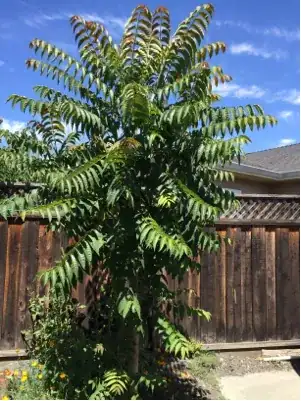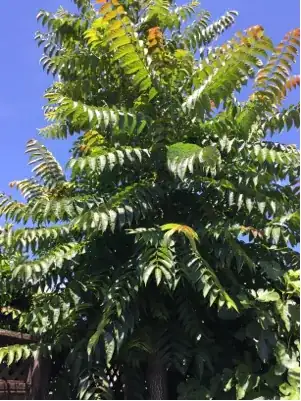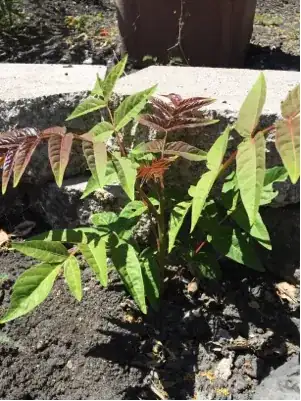This tree is all over our backyard and it keeps coming when i cut down, want to know if its a useful one if not, want to cut them down and apply glyphosate to the left over trunk..
-
1Both of these answers hold a lot of weight. Both of them are super plants and should not be killed so willy nilly. I'd like to know WHERE this tree resides on your property...Tree of Heaven and Sumac...are great plants. Yes you need to know about them and their propensity to survive with irritant saps...but it certainly depends on their location, your family, your needs. Otherwise I've planted LOTS of both residential and commercial. They are both kinda 'weeds' because they are such great survivalists! "A plant out of place is the description for weed"...need to know WHERE they live. – stormy Jun 11 '16 at 21:54
-
@stormy they live in northern California. Zone 9b – Anand Rockzz Jun 11 '16 at 21:56
-
@stormy I agree, totally. I hadn't thought of Rhus typhinus, as Bamboo has pointed out as a possibility when I answered. – AvieRose Jun 11 '16 at 22:05
-
1Unquestionably Ailanthus altissima. Unquestionably an undesirable and potentially dangerous weed. (The wood becomes vey brittle as the age and large limbs break of in winds). – Brenn Jun 13 '16 at 00:09
3 Answers
Possible that it is Ailanthus altissima 'tree of heaven'.
They are known for sending up suckers from their shallow root system. They originate from China, and were brought over to Europe in the mid 1700s and onto the United States later on in the century.
I've never been near one, but they can apparently develop a horrible odor.
- 1,558
- 1
- 11
- 19
I think its suckers from Rhus typhinus, or one of the sumachs anyway. They're fast growing and will appear along the length of roots under the soil from the original tree, so you may find as many as 5 or 6 sucker growths along each main rootline. If the original tree has died or been cut down, that simply means more suckers with more vigorous growth.
It's probably necessary to cut each one down and treat the stump or base with a brushwood or stumpkiller, now they've taken hold. Wear gloves when handling the foliage, the sap can be highly irritant in some people, and sometimes the suckers have thorns.
- 131,823
- 3
- 72
- 162
-
Sumacs in my area usually have that red discoloration on new leaves as well, and the wood has a very distinct smell (it doesn't smell terrible, but not good either). Also, some species of sumac are poisonous when burnt I've heard, so don't do that. – cutrightjm Jun 12 '16 at 03:08
Sumac and Ailanthus look very similar. Your stems look reddish brown, if they're also fuzzy it may be sumac. If you smell the leaves and it smells like what a plant fart would smell like if plants could fart it's ailanthus altissima. Ailanthus are horribly invasive trees and not ones you'd want to keep around but they're very hard to control. Ailanthus can not only take over your yard, your neighbor's yard it can also find it's way to natural habitats where it can harm the natural ecosystem. The roots can cause damage to sidewalks, foudnations, sewers, etc. Sumac while a native tree is also very invasive.
They're not very attractive trees and Ailanthus stinks. When they get big they release hundreds of thousands of seedpods everywhere.
Do everyone around you a favor and get rid of them. If you search around different forums you'll find plenty of people complaining about how difficult they are to control.
More detailed information on Ailanthus altissima control.
More on Ailanthus from http://www.ecolandscaping.org/05/invasive-plants/tree-of-heaven-an-exotic-invasive-plant-fact-sheet/
By the early 1900s however, tree of-heaven began losing popularity due to its prolific root sprouting and weedy nature in human-occupied areas coupled with the foul odor of its stems and leaves (DiTomaso and Kyser, 2007). Presently, in this new era of exotic invasive plant awareness, Dirr (1998), states that tree-of-heaven has no horticultural value because there are many other tree species of better quality for designed landscapes. Similarly, Whitcomb (1985 p.51) states that although it is an “indestructible tree” it “should be avoided”.
Someone on my block let an ailanthus grow in their yard and it's now huge. During the warm months I'm plucking a half dozen or more seedlings from my yard every week. If you see one in your yard do whatever it takes to eradicate it before it gets too big and costly to do something about it. If you have a neighbor that has some growing, educate them about the tree. Of all the invasive plants people have planted in my area this one is by far the worst.
Read this deleted answer from someone who is suffering with this tree. https://gardening.stackexchange.com/a/8339/2448
- 8,487
- 1
- 25
- 48



